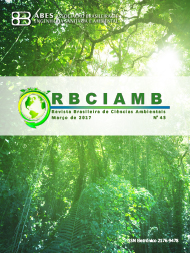INFILTRATION STUDIES ON SOAKAWAYS RECEIVING EFFLUENTS FROM SINGLE HOUSEHOLD UASB AND SEPTIC TANK REACTORS
DOI:
https://doi.org/10.5327/Z2176-947820170413Keywords:
decentralized treatment; UASB; septic tank; infiltration; sandy soil.Abstract
Clogging tendency has been analyzed in sandy soil soakaways at pilot scale
receiving either septic tank effluent (SUM1) or UASB effluent (SUM2) and
also at laboratory scale (SUMB1 and SUMB2), in relation to Chemical Oxygen
Demand (COD) and accumulated Suspended Solids (SS) concentrations.
Clogging was also estimated, by modeling the predicted time for infiltration
hydraulic failure. The laboratory results obtained with SUMB1 and SUMB2
confirmed the results obtained for SUM1 and SUM2, showing that
soakaways built in sandy soils which receive effluent from septic tanks
treating predominantly domestic wastewater tended to clog 58% faster than
those receiving UASB effluent. The good correlation observed between the
decrease in average infiltration rate and the time of operation suggests that
the UASB reactor is a promising technological alternative to septic tanks
as a pre‑treatment prior to effluent soil disposal for on‑site decentralized
wastewater treatment systems.
Downloads
Downloads
Published
How to Cite
Issue
Section
License
Copyright (c) 2017 Revista Brasileira de Ciências Ambientais

This work is licensed under a Creative Commons Attribution 4.0 International License.


























